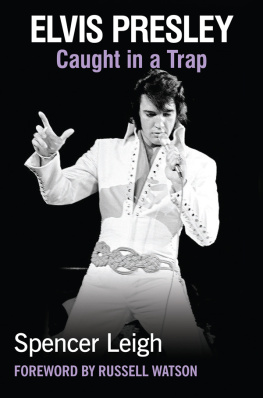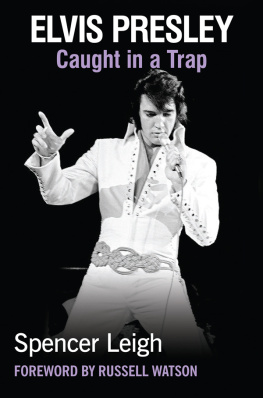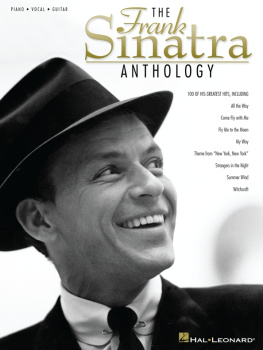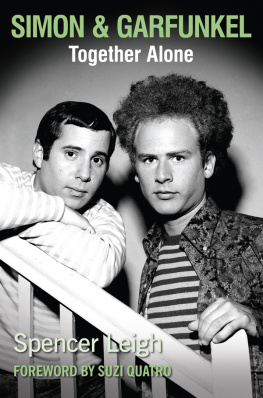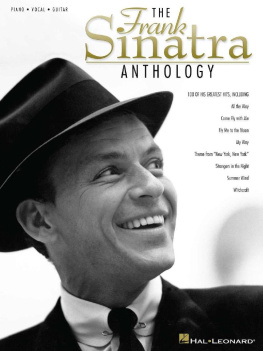
Published by McNidder & Grace
21 Bridge Street
Carmarthen
SA31 3JS
www.mcnidderandgrace.co.uk
Spencer Leigh
www.spencerleigh.co.uk
All rights reserved. No part of this work may be reproduced or transmitted in any form or by any means, electronic or mechanical, including photocopy, recording, or any information storage or retrieval system, without permission in writing from the publisher.
Spencer Leigh has asserted his right to be identified as the author of this work in accordance with the Copyright, Designs and Patents Act 1988.
Every effort has been made to obtain necessary permission with reference to copyright material. The publisher apologises if, inadvertently, any sources remain unacknowledged and will be glad to make the necessary arrangements at the earliest opportunity.
A catalogue record for this work is available from the British Library.
Designed by Obsidian Design
About the author
The journalist, author and broadcaster Spencer Leigh was born in Liverpool, England, and is an acknowledged authority on the Beatles. He has been broadcasting his weekly show, On the Beat, on BBC Radio Merseyside for 30 years and has interviewed thousands of musicians. He has written over twenty-five books, hundreds of album sleeve notes and he writes obituaries of musicians for The Independent and the Oxford Dictionary of National Biography. He is an Honoured Friend at Sir Paul McCartneys Liverpool Institute of Performing Arts (LIPA) and he has a Gold Badge of Merit from the British Academy of Composers and Songwriters. Spencer continues to live on Merseyside.
His acclaimed book, Best of the Beatles: The Sacking of Pete Best, is published by McNidder and Grace and is available in paperback and ebook.
Thanks
When it comes to acknowledging help, I must first credit the late Len Scarratt from the Wirral who has no idea that he has helped me in any way. He was a well-organised Sinatra collector whose possessions were removed in a house clearance. They were given to the Literally bookshop in New Brighton and its owner, Cathy Roberts, passed them to me. Another long-time collector, Babs Freckleton, passed over some VHS tapes which otherwise would have gone to a charity shop. Thanks to Billy Butler, Andrew Doble, Peter Doble, Peter Grant, Denny Seyton and in particular to David Roberts of poppublishing who did much to drum up interest in this project.
A special thank you to my wife, Anne, who has had to put up with my obsession with Frank Sinatra: she read the Kitty Kelley biography when it was published in 1986, decided that he was despicable and has had no further interest in him: I hope this is a more balanced view than Kelleys although Frank Sinatra certainly had his dark side.
I acknowledge the use of the British Library, the library attaching to the BFI Southbank and the BBC Written Archives in Caversham. These are all brilliant places with helpful staff. My thanks to Marion Leonard and the Institute of Popular Music at the University of Liverpool: they possess a wonderful vinyl archive with several shelves of Sinatra albums but, strangely, hardly anything by Dino.
I am very glad that Andy Peden Smith of McNidder & Grace was as intrigued by this subject as I was and I hope I havent let him down. I am grateful to the readers for this book David Charters, Fred Dellar and Patrick Humphries their comments were invaluable. David was asked by his son why he was spending so long on the book. Is it longer than War and Peace? he asked. No, its not quite that long, said David, but the themes are similar. Thanks also to publicist Linda MacFadyen and the books designer Bryan Kirkpatrick.
Contents
Illustrations
Frank Sinatra song sheets.
The general format of Frank Sinatra: An Extraordinary Life is to split the chapters into two parts: the first describes the background to something significant in Frank Sinatras life, and the second continues Franks story on a day-to-day basis. If you just want Franks life story, the second sections on their own form a continuous story. In Chapter 1 the first section describes life in Italy and America before Frank was born and how so many Italians found themselves in the United States.
Foreword
by Sir Tim Rice
In March 1965, I forked out the largest sum I had ever invested in a vinyl gramophone recording when I purchased a triple LP a compilation of Frank Sinatras greatest Capitol tracks entitled Sinatra The Great Years. This mono package set me back 5 at a time when that was the exact sum I was earning every week as an articled clerk in a solicitors office in London. In the 50 years since I handed over my hard-earned cash to Christopher Foss Records of Paddington Street, W.1., I have never regretted my extravagant purchase. The album (the 13th and I suppose the 14th and 15th I had ever bought) still holds an esteemed place in my collection and is still a regular on my turntable.
But half a century later, I realise that the financial aspect of my transaction was not the most important one. This was the first time I had bought a record that was not a rock era disc; indeed nearly half the tracks on it were recorded before Elvis Presley broke through with Heartbreak Hotel in 1956. From that year onward, although Sinatra and many of his refined colleagues, such as Dean Martin, Nat King Cole and Tony Bennett, continued to hit the charts, there was a definite them and us divide within the music-buying public; adults liked Sinatra and co. and were square (or sophisticated), kids were with-it (or moronic) and went for Elvis, Cliff and in due course the Beatles and the Rolling Stones. No-one was supposed to cross the generational barrier. But of course many did, in both directions, and what is more, found themselves perfectly happy on both sides of the fence. Spencer Leigh was clearly one of these open-minded music lovers. Frank Sinatra was not.
I have known and admired Spencers work as a music historian for many years. When he describes music and musicians of a bygone age, we become aware of so much more than the songs and performers the era itself returns to life and we are reminded that all art, notably popular art, is inspired by, and inseparable from, its time and place, and if we dont understand that background, the story is far from complete.
Spencer is primarily known, through his radio shows and his two dozen or so books, as a chronicler of the British pop and rock scene from 1955 to 1980 or thereabouts, but he has ventured Stateside on more than one occasion (Paul Simon, Buddy Holly) and revealed his great knowledge of popular music before he was born in such publications as Brother, Can You Spare a Rhyme. In his mammoth and wonderful tome on Frank Sinatra, he has superbly given us Americana through the long life and career of his subject which began way before his did. Sinatras agents, lovers, dodgy associates, show biz friends and enemies, passions, hatreds, bravery and recklessness, finesse and crudity, worldly wisdom and naivet, are all part of the complex whole and Leigh captures them all.
The sleeve note of Sinatra The Great Years asked were better records by a singer ever made? This is a pretty bold question, but on the other hand, someone must have made the greatest vocal recordings of all time and there are plenty who would support Sinatras claim to that honour. I would certainly place two or three of these great 19531960 Capitol sides in an all-time Top 40 male vocal performance chart, One For My Baby, The Tender Trap and All The Way being my favourites this week. Whether there has been a better telling of the Frank Sinatra story than Spencer Leighs version only someone who has read all the myriad other attempts can say I can say for sure that after reading
Next page

